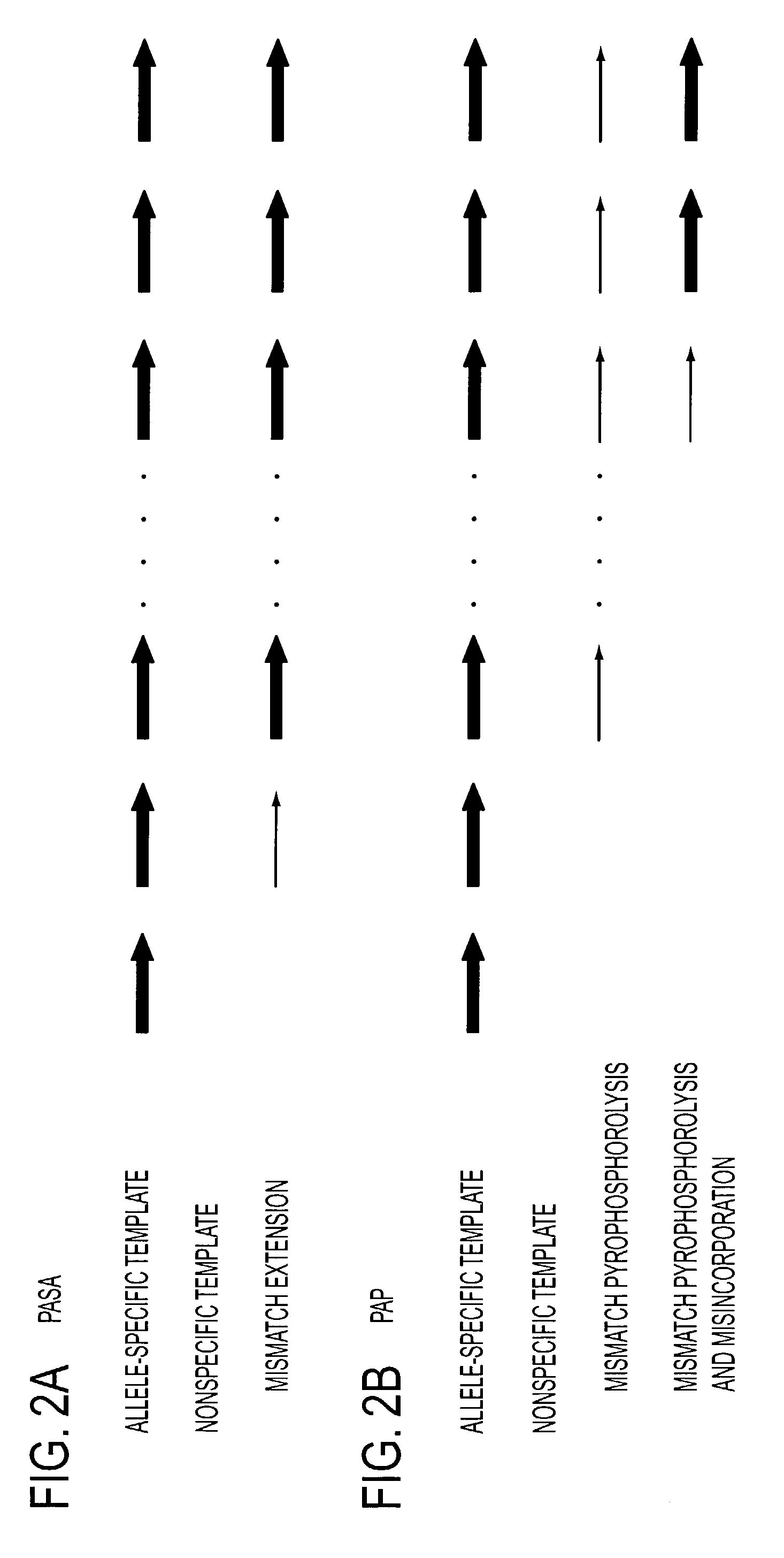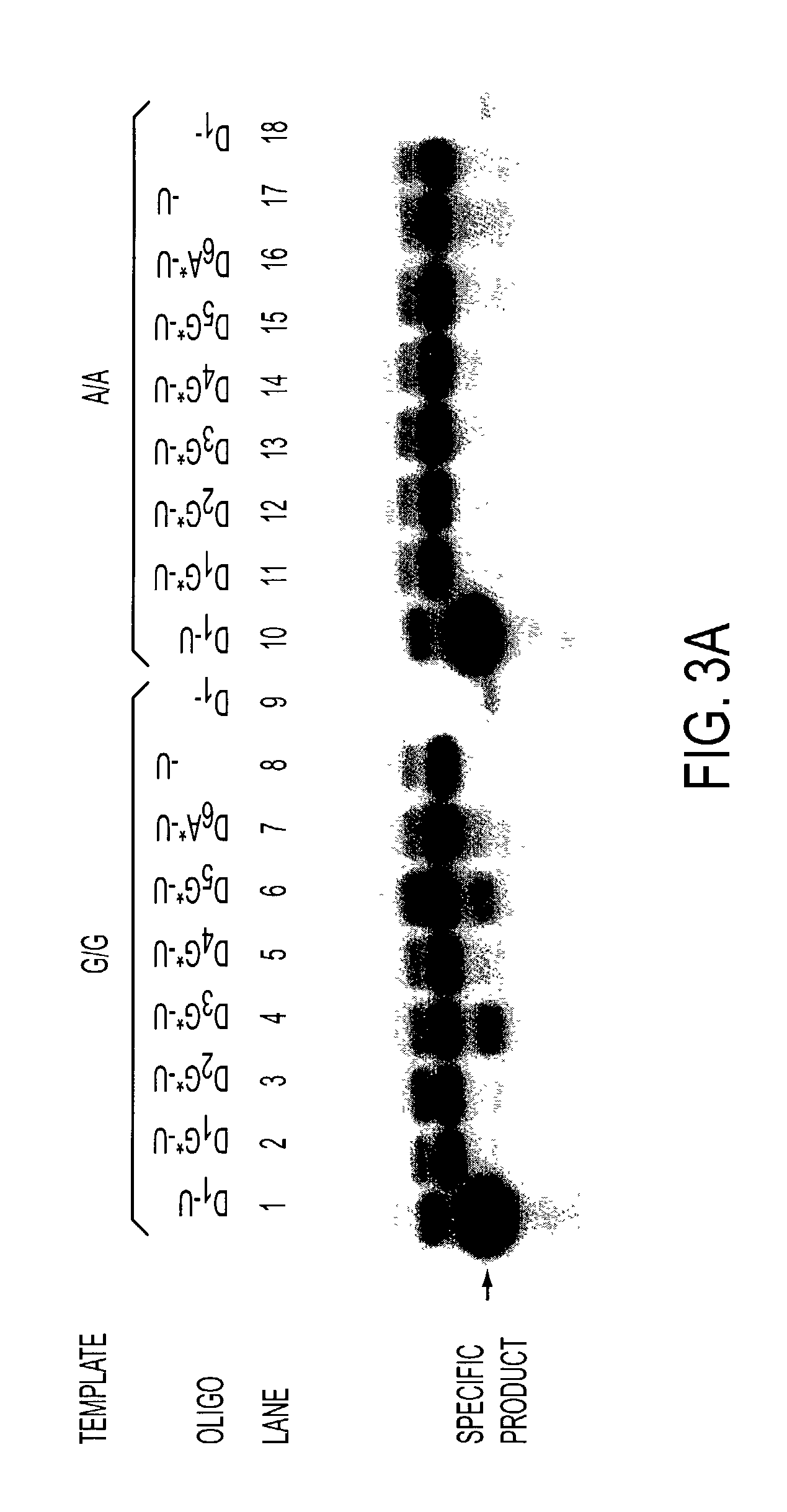Serial coupling of restriction cleavage and extension for nucleic acid amplification
a nucleic acid amplification and restriction cleavage technology, applied in the field of nucleic acid polymerization and amplification, can solve the problems of individuals with a high mutation load being at increased risk of cancer, and achieve the effects of low pyrophosphorolysis rate, high efficiency and low cos
- Summary
- Abstract
- Description
- Claims
- Application Information
AI Technical Summary
Benefits of technology
Problems solved by technology
Method used
Image
Examples
example 1
Preparation of Template by PCR
[0057]A 640-bp region of the human D1 dopamine receptor gene was amplified by PCR with two primers (T=5′ GAC CTG CAG CAA GGG AGT CAG AAG 3′ (SEQ ID NO:1) and U=5′ TCA TAC CGG AAA GGG CTG GAG ATA 3′ (SEQ ID NO:2)) (FIG. 1A). The TU:UT duplexed product spans nucleotides 33 to 672 in GenBank X55760 and the G+C content is 55.3%. A common A to G polymorphism is located at nucleotide 229, resulting in three genotypes of G / G, A / A and G / A (12). The PCR mixture contains a volume of 50 μl: 50 mM KCl, 10 mM Tris / HCl, pH 8.3, 1.5 mM MgCl2, 200 μM each of the four dNTPs (Boehringer Mannheim), 0.1 μM of each primer, 2% DMSO, 1 U of Taq DNA polymerase (Boehringer Mannheim) and 250 ng of genomic DNA from G / G homozygote, A / A homozygote or G / A heterozygotes. Cycling conditions included: denaturation at 95° C. for 15 seconds, annealing at 55° C. for 30 seconds, and elongation at 72° C. for one minute, for a total of 35 cycles (Perkin Elmer GeneAmp PCR system 9600). The PC...
example 2
Preparation of Template by PCR
[0091]A 640-bp region of the human D1 dopamine receptor gene was amplified by PCR with two primers (T=5′ GAC CTG CAG CAA GGG AGT CAG AAG 3′ (SEQ ID NO:1) and U=5′ TCA TAC CGG AAA GGG CTG GAG ATA 3′ (SEQ ID NO:2)). The TU:UT duplexed product spans nucleotides 33 to 672 in GenBank X55760 and the G+C content of the product is 55%. A common A to G polymorphism is located at nucleotide 229, resulting in three genotypes of G / G, A / A and G / A∥. The PCR volume is 50 μl: 50 mM KCl, 10 mM Tris / HCl, pH 8.3, 1.5 mM MgCl2, 200 μM each of the four dNTPs, 0.1 μM of each primer, 2% DMSO, 1 U of Taq DNA polymerase (Boehringer Mannheim) and 250 ng of genomic DNA from G / G homozygote, A / A homozygote or G / A heterozygotes. Cycling conditions included: denaturation at 94° C. for 15 sec., annealing at 55° C. for 30 sec., and elongation at 72° C. for one min., for a total of 35 cycles with a GeneAmp PCR System 9600 (Perkin Elmer Applied Biosytems). The PCR product was purified fr...
example 3
[0123]This example illustrates PAP amplification directly from genomic DNA. The oligonucleotides used in this example are listed below. The lane numbers refer to lanes in FIG. 10.
[0124]The downstream oligonucleotides in 0.1 μM concentration are:
[0125]
(SEQ ID NO:43)Lane 1: D1(204)25D5′ TCTGACTGACCCCTATTCCCTGCTT3′(A allele specific; SEQ ID NO:44)Lane 2: P*(206)24A05′ TGACTGACCCCTATTCCCTGCTTA*3′(G allele specific; SEQ ID NO:45)lane 3: P*(204)26G05′ TCTGACTGACCCCTATTCCCTGCTTG* 3′(G allele specific; SEQ ID NO:46)Lane 4: P*(206)24G−25′ ACTGACCCCTATTCCCTGCTTGGG*3′(A allele specific; SEQ ID NO:47)Lane 5: P*(228)26A−245′ TAGGAACTTGGGGGGTGTCAGAGCCC* 3′
[0126]The opposite upstream oligonucleotide in 0.1 μM concentration is: D1(420)24U 5′ ACGGCAGCACAGACCAGCGTGTTC 3′ (SEQ ID NO:48), which was paired with each downstream oligonucleotide. See Footnotes of Table 3 for details.
[0127]The other components were the same as in Example 2, except for the following: 0.5 U of each of AmpliTaqFS and Taq DNA p...
PUM
| Property | Measurement | Unit |
|---|---|---|
| pH | aaaaa | aaaaa |
| pH | aaaaa | aaaaa |
| volume | aaaaa | aaaaa |
Abstract
Description
Claims
Application Information
 Login to View More
Login to View More - R&D
- Intellectual Property
- Life Sciences
- Materials
- Tech Scout
- Unparalleled Data Quality
- Higher Quality Content
- 60% Fewer Hallucinations
Browse by: Latest US Patents, China's latest patents, Technical Efficacy Thesaurus, Application Domain, Technology Topic, Popular Technical Reports.
© 2025 PatSnap. All rights reserved.Legal|Privacy policy|Modern Slavery Act Transparency Statement|Sitemap|About US| Contact US: help@patsnap.com



